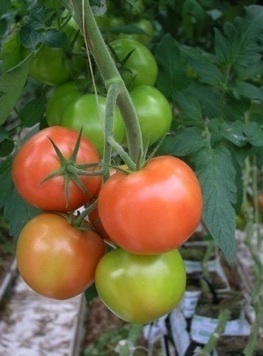
 NEWS HIGHLIGHT
NEWS HIGHLIGHT
Tomatoes loaded
with health benefits
The tomato is an incredible food. Not only is it low in calories and high in fibre and nutrients, it’s relatively inexpensive and has a variety of uses.
July 24, 2009, Columbus, OH — We love eating tomatoes during the summer. What are their best qualities, nutrition-wise?
The tomato is an incredible food. Not only is it low in calories and high in fibre and nutrients, it's relatively inexpensive and it can be used in a wide variety of ways.
Here are the basics: A half-cup of tomatoes — basically, half of a large (3-inch diameter) tomato, has just 15 to 20 calories. But this small, tasty package is a good source of vitamin C, vitamin A, vitamin K, potassium, manganese and fibre. It also contains smaller amounts of vitamin E, the B vitamins (especially thiamin, niacin, vitamin B6 and folate), and other minerals including chromium, copper and magnesium.
Tomatoes are also a rich source of antioxidants. In particular, tomatoes are chock-full of lycopene, a carotenoid (which means it's in the same family as beta-carotene, which is where tomatoes get their vitamin A).

|
What's so great about lycopene? Numerous studies link it with lower rates of several kinds of cancer, including colon, rectal, prostate, breast, endometrial, lung and pancreatic cancers. And research also indicates that it could improve heart health, linking higher blood levels of lycopene with lower rates of cardiovascular disease.
Some recent studies suggest that lycopene can't get all the credit for tomato health benefits. Rather, researchers believe that a synergy of phyonutrients (plant-based nutrients), including lycopene, in tomatoes and tomato products should be given credit.
Studies also show that it's not just tomatoes in their raw form that give your health a boost. For example, the lycopene in processed tomato products, including juice, sauce and paste, is more readily absorbed by the body than the lycopene in raw tomatoes. A bit of oil in the product also helps your body's ability to absorb the nutrients.
When buying raw tomatoes, select those with the deepest, richest red color. Not only will they have the most lycopene, but they'll be the ripest, too.
Tomatoes can ripen after they're picked from the vine. According to an Ohio State University Extension fact sheet ("Selecting, Storing and Serving Ohio Tomatoes"), choose tomatoes that are firm, glossy, smooth and plump. Avoid those that are soft, bruised, cracked or otherwise damaged.
Store tomatoes that need further ripening at room temperature (21 degrees C) and out of direct sunlight — the sun could cause uneven ripening. Place them stem-end up; the bumpy "shoulders" of the stem end are the most tender part of the tomato and could bruise simply bearing the weight of the fruit.
Chow Line is a service of Ohio State University Extension and the Ohio Agricultural Research and Development Centre. Send questions to Chow Line, c/o Martha Filipic, 2021 Coffey Road, Columbus, OH, 43210-1044, or filipic.3@cfaes.osu.edu.
This column was reviewed by Julie Shertzer, registered dietitian and program specialist for Ohio State University Extension in the Department of Human Nutrition, in the College of Education and Human Ecology.
Print this page